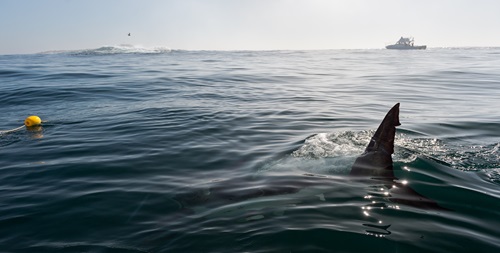
Just when you thought it was safe to go back in the water.
With open water swims, triathlons, surfing and other ocean-based water sports, it behooves event owners and organizers to help minimize the risk of shark attacks and make participants aware of what to do (and not do) if sharks are sighted in the area.
Although shark attacks are still considered rare, a few recent incidents have put people on edge. On June 7, three back-to-back shark attacks occurred in waters off Florida’s Gulf Coast, resulting in injuries to two teens and one woman, reports USA TODAY. Shortly thereafter, a man in his 40s was critically injured in another shark attack in the waters off Amelia Island in Northeast Florida. And on July 1, another man was the subject of an emergency call after a shark bit him on the arm. Other attacks have been reported in Oahu, Hawai’i.
Although such reports may contribute to the perception that shark attacks are on the rise, the Florida Museum of Natural History puts the odds of being attacked by a shark at 1 in 11.5 million. In fact, attacks in the U.S. have actually trended down in recent years.
Worldwide, there were 69 unprovoked shark bites on humans in 2023, and 36 of them were in the U.S. Two of the 36 were fatal: one in Hawaii, the other in California. Florida saw 16 shark attacks, more than any other state, just like in previous years, according to the Florida Museum’s International Shark Attack File report. In 2023, there was a 12.2 percent decrease in shark bites compared with 2022.
 Since 1837, there have been 1,632 unprovoked shark bites in the U.S., most of which—928—occurred in Florida, notes the International Shark Attack File. That's largely because of the state's 1,350-mile coastline, the largest in the contiguous U.S., which has an abundance of shoreline prey for sharks as well as year-round tourists who enjoy Florida’s beaches. In fact, there’s no beach in Florida where it’s impossible to come across a shark. It’s home to the “Shark Bite Capital of the World,” better known as Volusia County, home of Daytona Beach, which ranked the highest with 351 unprovoked shark attacks (the oldest on record dates to 1837). Volusia's neighbors to the south, Brevard and Palm Beach counties, have the next highest with 158 and 83 attacks, respectively.
Since 1837, there have been 1,632 unprovoked shark bites in the U.S., most of which—928—occurred in Florida, notes the International Shark Attack File. That's largely because of the state's 1,350-mile coastline, the largest in the contiguous U.S., which has an abundance of shoreline prey for sharks as well as year-round tourists who enjoy Florida’s beaches. In fact, there’s no beach in Florida where it’s impossible to come across a shark. It’s home to the “Shark Bite Capital of the World,” better known as Volusia County, home of Daytona Beach, which ranked the highest with 351 unprovoked shark attacks (the oldest on record dates to 1837). Volusia's neighbors to the south, Brevard and Palm Beach counties, have the next highest with 158 and 83 attacks, respectively.
While the chances of being bitten by a shark are rare, and the odds of dying as a result of a shark attack in the U.S. are even more miniscule (1 in 3,748,067 according to calculations from USA TODAY), risks should always be minimized. Deterrence is key, says The International Shark Attack File, which lists multiple ways swimmers and other open water sports athletes can protect themselves.
Use of technology, such as drones, smart drumlines and electronic tracking tags, is also becoming more prevalent in helping to pinpoint sharks’ whereabouts and prevent attacks. For example, UAVs are now on shark patrol across many beaches in New York, Florida, California and Hawaii. But there is one caveat, states Axios: “As sharks get easier to spot thanks to emerging technology, the number of sightings is likely to increase; yet that doesn’t necessarily mean that there are more sharks around than there were before.”
A few companies have even developed electronic devices to help anglers and water sports participants deter sharks. A leader in the field is Sharkbanz, which uses an electromagnetic shark-deterrent technology. The innovation, which employs an electromagnetic field to harmlessly ward off sharks and stingrays, was originally developed for fishing tackle to keep sharks away from hooked fish. The company’s wearable device, the Sharkbanz 2, is designed for surfers, swimmers, divers and beachgoers.
One of the proponents of the Sharkbanz is Bethany Hamilton. The competitive surfer lost an arm in a shark attack in 2003, but went on to compete and later, to become a motivational speaker. Her experience was the subject of the movie, Soul Surfer.
Sharkbanz wearable and fishing products both use the same deterrent technology which is always “on” and doesn’t require batteries or charging (they are powered by the magnetic field of the earth). The devices work by disrupting a shark’s or stingray’s sensitive electroreception, and isn’t harmful to sharks or other ocean animals.
The takeaway here is that although no shark deterrent is 100 percent effective, heeding safety protocols and being aware of risk factors will minimize the risk of a shark attack.

